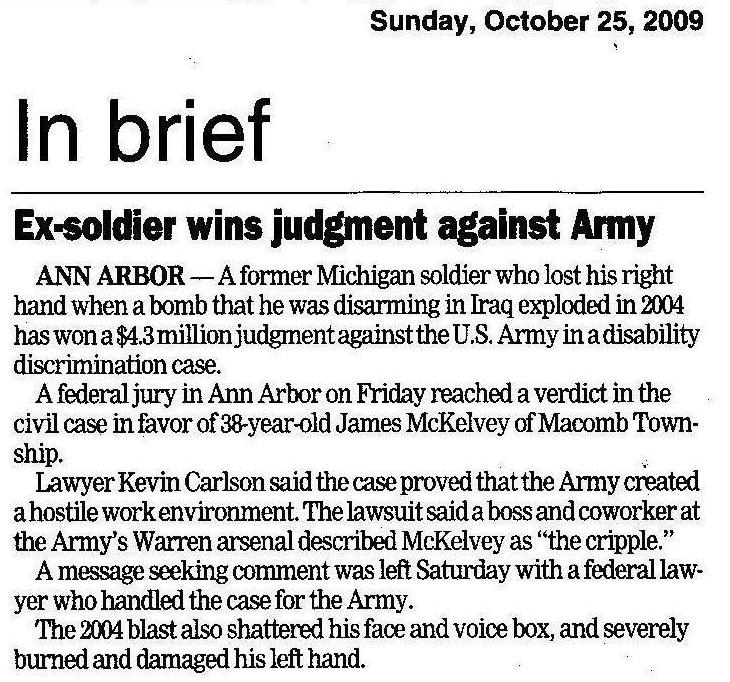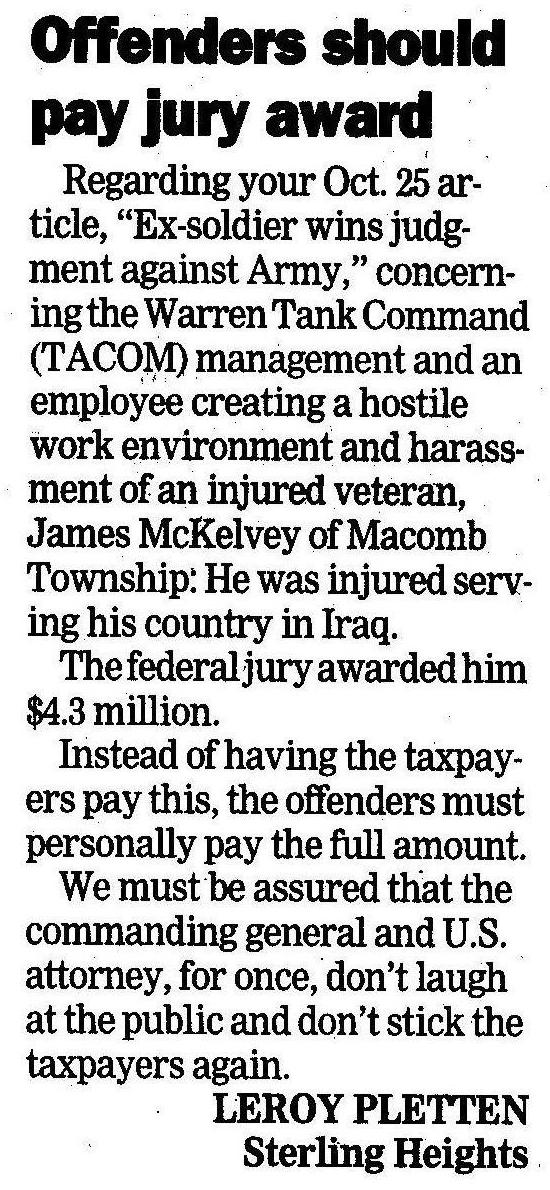Another Victim: Iraq War Veteran James McLelvey



TACOM treated McKelvey and Tenenbaum kindly compared to what it did to Pletten. For background, see, e.g.,
compliance in the "here and now," Watson v City of Memphis, 373 US 526, 533; 83 S Ct 1314; 10 L Ed 2d 529 (1963) (park context) at one's present location, Missouri ex rel Gaines v Canada, 305 US 337; 59 S Ct 232; 83 L Ed 208 (1938) (education context), and the "right to work," Yick Wo v Hopkins, 118 US 356; 6 S Ct 1064; 30 L Ed 220 (1886); Truax v Raich, 239 US 33; 36 S Ct 7; 60 L Ed 131; LRA 1916D, 543; Ann Cas 1917B, 283 (1915), including in safe conditions, American Zinc Co v Graham, 132 Tenn 586, 589; 179 SW 138, 139-140 (1915), cited by Prof. Alfred Blumrosen, et al, "Injunctions Against Occupational Hazards: The Right to Work Under Safe Conditions," 64 Cal. Law Rev (#3) 702 at 712 n 48 (May 1976).
Note data on prior pro-drug action by Army officers, as documented, click here for details. See also data on Pentagon workers and child pornography (Boston Globe, 23 July 2010).
U.S. Attorney consiglieres aid and abet, contrary to their public posing and posturing of being "anti-drug" and anti-pornography.
It is long-term government policy to attack whistleblowers. In attacking a whistleblower, agencies (aided and abetted by the Department of Justice, an agency "against the best interests of the United States in terms of [stopping drugs and crimes such as rape]," including by its firm policy and practice against prosecuting agency crimes against whistleblowers):
“go well beyond merely defeating a whistle blower . . . prove to others that no one is safe . . . make the most outrageous charges possible. . . . for purposes of teaching others a lesson, the more obvious the inconsistency [with work record (and law)] the better . . . .”—Thomas M. Devine and Donald G. Aplin, “Whistleblower Protection—Gap Between Law and Reality,” 31 Howard Law J (#2) 223, 226 (1988).
Ed. Note: See similar law review articles by, e.g.,
|
| Ed. Note: Other felonies include violation of
|
"Both in monitoring and information activities, the . . . safety program at [TACOM] served largely to check the possibility of an immediate, acute exposure crisis resulting from [TTS] and to reassure the [employees] that one would not occur. Long-term consequences of exposures below the acute symptom "threshold" were measured, analyzed and explained in terms of nationwide or worldwide populations placed at small risk, not in terms of local communities placed at greater risk. In both regards, monitoring and information, the employees of the defendant [TACOM] negligently and wrongfully breached their legal duty of care to [employees including Mr. Pletten] as [on-site personnel] placed at risk." Allen v. United States, 588 F. Supp. 247, 404 (D. Utah 1984), rev’d on other grounds, 816 F.2d 1417 (10th Cir. 1987). "[T]here is just nothing wrong with telling the American people the truth."
Violations of TACOM's Own Discipline Regulation
Inconsistencies with the Rule of Law
Australian Prof. Brian Martin's Site on This Case